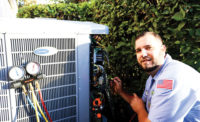High-end air conditioners feature an array of benefits and options to fit most consumers’ wants and needs. And while the overall a/c market is growing, according to the Air-Conditioning, Heating, and Refrigeration Institute’s (AHRI’s) shipment data, the market is still dominated by entry-level product, according to Tim Brizendine, director of product management, Cooling, Lennox Intl. Inc.
“Overall, we have seen year-over-year growth on higher-efficiency models as they have come out,” he said. “That is really being driven by technology: the introduction of variable capacity units in particular. With variable capacity, not only are we getting considerable efficiency benefits, but what also comes with it are comfort benefits and the ability to maintain temperature very precisely within the space without having big swings with the systems coming on and off. There’s also a higher level of sophistication in terms of better capability to control things like humidity, so we can not only cool but dehumidify more optimally, making for a much more comfortable space.”
Justin Stephens, product manager, Bosch Thermotechnology Corp., said the market for high-end systems is growing, mainly because consumers want to control their comfort.
“Customers look for products that will make their lives easier,” he noted. “Nowadays, people turn on the television and see numerous home improvement shows featuring products people didn’t realize they could have. Additionally, manufacturers are promoting these technologies, making consumers more aware of what can be done.”
Johnson Controls Inc. has also experienced growth within the high-end category as homeowners shift from a utilitarian focus to a demand for advanced features and capabilities, including energy efficiency, IAQ, and smart home integration, according to Micah Ogé, marketing manager, residential portfolio marketing, Johnson Controls.
“Homeowners are no longer viewing their HVAC system as just the mechanics of their homes; they are now seeing HVAC as a vital component to the comfort, health, and convenience of their home life,” Ogé said. “When viewed in these terms, homeowners are willing to invest in upgraded, high-end systems.”
REFINED PERFORMANCE
High-end air conditioners have the ability to provide just the right amount of cooling that’s needed for the house, so it uses small increments of capacity as the demand increases or decreases, Brizendine explained.
“High-end systems also allow someone to control all the parts of the system separately — the indoor airflow and outdoor compressor,” he said. “It’s optimized for the conditions you have both externally and internally within the space. We can dehumidify better and cool better. And with these features come other benefits, too. Being able to run at lower speeds means the system will be much quieter; you won’t even know it’s running.”
Lennox is continually pushing to reach higher efficiencies as comfort becomes more of a market demand, Brizendine said.
“Just like everything else, we’re getting more and more homeowners who want the ability to have more information and control at their fingertips, “ he said. “We now have a lot more data and information, so we can customize the system better as well as provide better feedback on how the system is working, making it easier to set up, commission, and control.”
One main feature of high-end systems is the integration with Wi-Fi thermostats and wireless room controllers to control the temperatures in separate rooms, Stephens noted.
“Consumers are becoming more aware of the technology available to them,” he said. “They now expect it to be in their homes as it becomes more integrated into our lives. The customers talk with installers, wholesalers, and manufacturers to understand what’s available. The manufacturers listen to what customers want and build it into their products to meet the customers’ needs.”
According to Ogé, Johnson Controls has seen several core components resonate with homeowners who invest in high-end systems, including zone controls, IAQ, smart technology and touchscreen thermostats, and advanced system monitoring.
Zone control is popular because homeowners can see a decrease in energy consumption and utility costs as a result of the customized output options it provides, he said. Additionally, IAQ has become just as important, if not more important, to homeowners than energy efficiency and cost savings.
“Homeowners are trusting their home health to their HVAC system and are willing to invest in high-end systems that can reduce dust, allergens, bacteria, mold, and mildew,” Ogé said.
“Additionally, sales of Wi-Fi-enabled smart thermostats have almost tripled from 2013 to 2016, and this number is continuing to grow. Consumers are looking for integrated systems that have the ability to make decisions for them based on learning occupant behaviors.
“And in terms of advanced system monitoring, York has Charge Assurance™, which can help contractors set up new systems more quickly while providing a self-monitoring capability that can provide notifications to both the homeowner and contractor, if desired,” he added.
High-end air conditioners also incorporate variable-speed technology, said Ogè, which circulates air quietly and precisely and can dynamically adjust capacity and airflow to accurately match changing comfort needs for maximum comfort and minimized power consumption, as they may use up to 80 percent less electricity than conventional PSC blowers typically found in base model air handling units.
“Millennials entering homeownership have greatly shaped these trends,” Ogé said. “Many millennials are seeking older, ‘fixer-upper’ homes and are willing to upgrade the existing systems. This emerging group of homeowners are approaching home maintenance as they do most aspects in their lives, placing a value on personal health, convenience, and energy efficiency — not only from a money-saving standpoint but from an interest in environmentally focused products and companies that demonstrate social responsibility. Additionally, the Google/Alexa effect has driven homeowners from all stages of life to have a greater acceptance of smart devices and systems in the home.”
Publication date: 6/25/2018
Want more HVAC industry news and information? Join The NEWS on Facebook, Twitter, and LinkedIn today!











